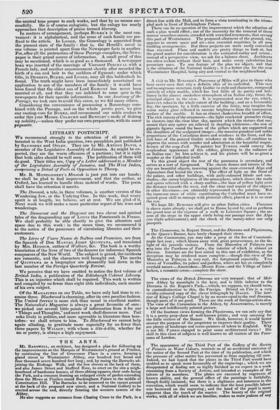THE ARTS.
Mr. BARDWELL, an architect, has designed a plan for following up the improvements on the Marquis of Westminster's ground at Pimlico, by continuing the line of Grosvenor Place in a curve, forming a grand street to Westminster Abbey, one hundred feet broad and four thousand seven hundred feet long; and, by razing the Barracks ad- joining the Birdcage Walk, and the low streets at the back of them, and also James Street and Stafford Row, to erect on the site a neigh- bourhood of handsome houses, of three oblong squares, their ends facing the Park, and a crescent fronting an enlarged circle of garden extending from the Mews at Pimlico round Buckingham Palace to the middle of Constitution Hill. The Barracks to be removed to the vacant ground at the back of the proposed new street, and a National Gallery to be erected across the end, directly fronting the western towers of the Abbey. . He also suggests an entrance from Charing Cross to the Park, in a
direct line with the Mall, and to form a vista terminating in the trium.- phal arch in'front of Buckingham Palace.
There can be no question of the improvement which the adoption of such a plan would effect; nor of the necessity for the removal of those narrow sewerless streets, crowded with wretched tenements, that occupy- this part of Westminster. The proposed allotment of the ground, too, appears to secure space and air—two essential requisites in all new building arrangements. But these projects are more easily conceived- than executed. Plans and models are pretty things to look at, but the grand matter for consideration is the estimated outlay and return : instead of a perspective view, we ask for a balance sheet. Architects too often reckon without their host, and make every calculation but pecuniary ones. To one feature of the plan we object, and that is the situation of the National Gallery ; it is a better site for the new Westminster Hospital, being airy and central to the neighbourhood.


























 Previous page
Previous page